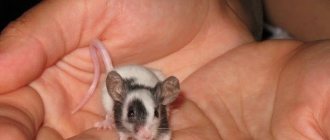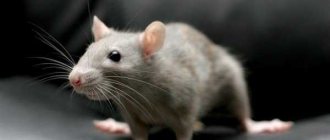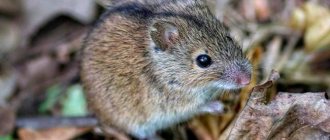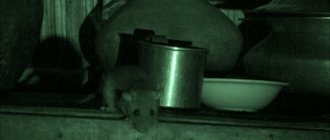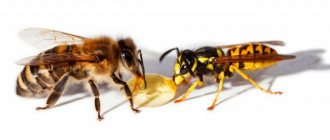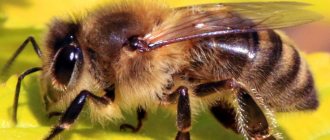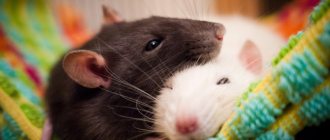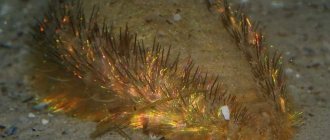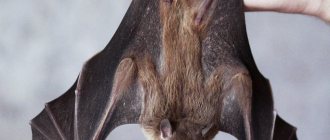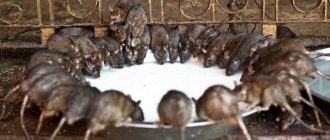Rats and mice are widespread throughout the planet. Representatives of both families prefer to settle close to people in order to make it easier for themselves to obtain food.
Seeing a gray rodent with an elongated muzzle, not everyone can immediately determine who is in front of him - a mouse or a rat. But these animals have quite a lot of differences, and they concern not only their appearance, but also their habits, food preferences, and level of intelligence.
Types of mice
There are about 300 of their representatives. Some of them are decorative and are specially selected for home maintenance. These, for example, include tiny mice with a body length of about 7 cm. These rodents are brightly colored. At the same time, the juveniles have brownish, dull fur. After the first molt occurs, the rodents become bright red. They are kept in spacious cages and must be fed invertebrates, grains and greens.
The largest mouse is the Asia Minor mouse, reaching 13 cm. It is mainly found in Asia, Georgia in mountainous areas.
In the central regions, the field mouse is mainly widespread, which rarely settles in human buildings. Her tail is a quarter less than her body length. The color is reddish-brown on the sides, with a black stripe running down the center of the back. However, coloration for rodents is not one of the main characteristics by which they can be distinguished, since it differs somewhat by region, and due to their migration, it can change beyond recognition.
The most common taxonomic unit that inhabits homes is the house mouse. This type of mouse is characterized by the fact that their length reaches 10 cm, the tail can be the same length as the body length, or be half of it. During its existence with humans, it has adapted to its food, eating plant and partly animal products that humans consume. In the summer they can go to the fields, where they feed on grain, and with the arrival of autumn they move to human habitation.
Also, wood mice can settle in houses during autumn migration.
Do rats eat mice?
Rats are predators, dexterous and skilled hunters. They can catch fish, attack amphibians, chicks, small birds and animals. Rats eat mice too. It cannot be said that this is their main prey; rather, on the contrary, a rat will attack a mouse only if circumstances force it to do so. Among the most common:
- hunger (a hungry rat does not choose who to eat);
- competition (if the mouse encroaches on prey that the rat considers its own, or simply ends up in the rat’s territory);
- population growth (as the number of rats increases, they begin to occupy more and more new territories and can attack the mice that live there);
- defense (if some desperate mouse attacks a rat, it will fight and almost certainly win, and then eat the defeated enemy).
In addition, a dead or weak mouse that gets in the way of a rat may be eaten.
Rat breeding
Determining the sex of a rat is quite simple: males are larger and heavier than females, and by the age of 1.5-2 months, large testicles grow at the base of the animal’s tail.
The age of a rat can be determined by weighing the animal:
- At 2 months, males weigh 160-220 g, females 150-200 g;
- At 3 months, males weigh 250-310 g, females 210-250 g;
- At 4 months, males weigh 350-410 g, females 250-290 g;
- At 5 months, males weigh 450-490 g, females 290-340 g.
When a rat is six months old, its weight remains unchanged
To understand that this is an old specimen, pay attention to the following signs:
- the animal's fur becomes sparse, dull, and sticks out in places;
- the skin on the tail becomes rough, rough, with many flaking keratinized particles;
- the incisors become significantly longer. Their back part is ground down, and the teeth take on the shape of a chisel.
Rodents living in their natural habitat breed mainly in the warm season, mainly in spring and autumn. Rats living close to human habitation, or decorative individuals, can reproduce regardless of the time of year.
The female's pregnancy lasts 22-24 days, after which 8-10 cubs are born. Rats are born naked, blind and helpless, so they need extra care. The problem is that babies cannot pass feces and urine on their own. The owner can help them along with the mother rat by massaging their bellies from time to time. This helps stimulate excretory processes.
What do rats and mice have in common?
These mammals belong to the order of rodents of the mouse family. There are other common features. Because of them, these two species are often confused.
Mice and rats: general features of life
Both of them belong to cosmopolitan species. That is, these rodents inhabit all corners of the Earth except Antarctica and the Far North, and they are not found high in the mountains.
These rodents are considered synanthropic, that is, associated with humans. Wild subspecies live in human homes, utility rooms or those intended for keeping pets. Although in warm regions they can live far from human habitation.
Rodents are animals with a nocturnal and twilight lifestyle. They are most active at sunset. However, when kept in captivity, animals adapt to the rhythm of life of the owner, get used to staying awake in the light and reducing activity during human rest.
These types of rodents are very active. They climb, run, jump and swim beautifully. Possessing high plasticity of the body, the animals can “leak” into very small crevices.
In nature, mice prefer to live in colonies in which they maintain a hierarchy. Adult males can start fights among themselves. In families, aggression sometimes spreads to older offspring, which the parents expel from their territory.
Rodents are clean creatures. They keep their homes clean and tidy. The droppings and piles of dust held together by urine that they leave while moving are special marks for determining the route.
Both types of rodents not only live in nature, but also take root in captivity and are easily tamed. Today, breeders, which many fanciers are happy to keep as companion animals.
Similarity in appearance
The mouse really looks like a smaller copy of a rat:
- The house mouse and are covered with horny scales and sparse short hairs. Only the black rat stands out here. Her tail is covered with thick hair.
- Both species have round black eyes (in albinos they are red or dark ruby).
- The main characteristics of these two types of rodents are long, sharp incisors that grow throughout their lives and the absence of fangs. With their teeth, animals can gnaw through very hard materials, even concrete.
Who is smarter - rats or mice?
The intelligence of rats is considered higher than the intelligence of mice: large rodents are much more difficult to catch, they easily bypass all kinds of traps, showing miracles of courage, caution and cunning. Even if this animal gets into trouble, it will always give a sign to the other members of the colony, who will subsequently begin to bypass the dangerous place.
Caution will prevent this rodent from eating poison, while a mouse can easily mistake a poisoned treat for a treat.
These animals carefully check the area before moving in, sending the strongest, most cunning and hardiest individuals for inspection. In a rat colony there is a strict hierarchy, for ignoring which the animal can be expelled.
Rats are able to overcome many obstacles by working together perfectly and harmoniously. These animals can even come up with their own games and entertainment.
Mice, in turn, adapt more easily in captivity and become an excellent friend and companion for humans.
What is the difference between a baby rat and a mouse?
Norushki are capable of constantly falling into the same trap. The animals without hesitation swallow bait with poison and climb into mousetraps.
A rat is not so easy to deceive
She spends a long time sniffing at suspicious objects and behaves cautiously. The animal can identify traps and traps for rats and avoids them
The rodent is able to explore the surrounding space and analyze. If the area is safe and comfortable, the rat will lead the rest of the pack there.
People who keep decorative rats claim that their favorite rats respond to their name, recognize the one who feeds and waters them and learns simple tricks. Mice are not capable of this.
Baby rats and mice
Baby mice and baby rats have the following differences:
- Mice have a pointed muzzle. Baby rats have a blunt nose.
- The mice's ears are large and round. Rats have a triangular ear that is pressed to the skull.
- The tail of a newborn minnow is long, but in rat pups it is thick and short.
- Small mice do not have skin folds between their fingers.
A baby rat reaches the size of an adult mouse in a month. At this point, it becomes difficult for many to distinguish a mouse from a baby rat. If the animals cannot be seen closely, then you need to navigate by the rat’s trail on the snow or ground that they leave:
- The print of mouse limbs does not show webbing between the toes.
- Rat tracks are located at a distance from each other. Fingers stuck out. The paw print is wide.
If you compare what baby rats and mice look like in the photo, it’s not difficult to distinguish the babies.
If it is difficult to recognize the difference between a mouse and a rat, then you should look into a pet store. Decorative animals behave in the same way as their wild relatives. The appearance of the animals also does not differ much from those of “free” rodents.
The mouse's body is small and round, with a short rounded muzzle and large beady eyes. The hearing organs of mice also have considerable size in comparison with the head; unlike those of rats, they are thinner and rounded.
The fur of a mouse is silky and soft, with a particularly striking example of the difference being the fur of a mature male rat, which is more like coarse lint. Of course, most ordinary people are unlikely to ever want to intentionally touch these animals in order to make sure of the difference, but for those who kept such pets, this difference is obvious.
The jaws of rats have two pairs of fairly long incisors. The primary molars are designed to thoroughly grind food, so they grow in dense rows. Despite the fact that rats are considered predators, they do not have the fangs inherent in the latter.
Another extremely interesting fact about how mice differ from rats is the following: rats have more nipples. Mice have 10 of them, rats have two more. But despite this difference, the animals have the same average litter, which is about 8-9 cubs.
Rats have more developed intelligence than mice (this also applies to domesticated rats and mice). But this does not mean at all that a mouse is a bad pet. Decorative rats are very smart animals that quickly make contact, and they also quickly become attached to their owner.
They are trainable and can express their affection and love. In addition, the decorative domesticated rat knows and responds to its name when it is called to itself, especially if the owner offers some kind of delicacy or fun activity.
Essentially, the intelligence of a pet rat can be compared to that of other pets (cats and dogs). Rats are sociable animals that respond well to people, as evidenced by their love of games.
Note that even in natural conditions, rats are smarter than their smaller brothers - mice
For example, a wild rat is not so easy to catch, this is explained by its caution. She will never eat unfamiliar food found in a new territory she has just entered.
That is, these animals are much more difficult to trap or poison.
How to determine the sex of baby rats
Unlike adults, it is not easy to distinguish the sex of newborn rat pups and this can be done when the babies are at least four to five days old. Since small rodents are devoid of fur, you can determine the sex of a baby rat by the nipples on the tummy, which resemble tiny pimples. The presence of mammary glands indicates that this is a girl, because boys, both in adolescence and in adulthood, do not have nipples.
Also, in male babies, you can see small dark spots located between the genitals and the anus, in the place of which testicles will form as the animal grows older.
Appearance
Let's start comparing mice and rats with this indicator. Despite the fact that rodents are nocturnal animals, they can sometimes be seen. This moment usually does not last long, and in this short period of time you need to have time to assess your parameters, physique and weight.
A mouse is a rodent that can get into any crack in the house. The size of the body to the tail is no more than 12 cm, the thin tail is approximately the same as it or slightly smaller. On the paws of rats there are membranes between the toes; the paws themselves are wider and more muscular compared to mice, which are adapted for movement in vertical planes.
This animal can reach a length of 40 cm with an average length of 30 cm.
These rodents have different skull shapes. Mice have a triangle-shaped muzzle, flattened, with brightly highlighted small black eyes. Rats have an elongated muzzle with a conspicuous nose.
They have a tail thickened at the base, the base is covered with hair, then there is a scaly covering on bare skin. Mice have a thin tail, entirely covered with hair. At the tip there is a brush with long hairs on it.
We will continue the description of the mouse and rat by comparing them by ears, eyes, neck and noses. The former have ears wide at the base, which are always in a standing position. Their nose is flattened, and their eyes are large relative to their muzzle. Rats have small elongated ears that are pressed to the head. The eyes are relatively small. The nose has an elongated shape. The mouse's neck is not pronounced; the rodent's silhouette resembles a ball. In the rat it is pronounced, the body is elongated.
Weight, one might say, is the main indicator by which one can immediately distinguish the type of rodent. The largest mouse can reach 50 g in weight, while the average rat weighs about 500 g.
In addition, comparisons between mice and rats can be made by smell. So, the smell coming from mice is similar to the aroma of dirty socks, while the smell of musk or honey remains after rats.
External differences
The main signs of differences between rats and mice can be observed in external characteristics. First of all, they are clearly visible in the mass of animals, as well as in the structure of the body. Based on them, you can easily determine which representative of the rodent family is in front of you.
Dimensions
The most significant difference between rodents is determined by size. Rats have significantly larger dimensions and a stocky body. The length of an adult can reach 30 cm, not counting the tail. At the same time, weight indicators fluctuate between 600–700 g. A mouse is a smaller rodent. It rarely grows more than 10 cm in length, and its weight does not exceed 30 g.
Tail
It is also not difficult to distinguish animals by the characteristics of the tail. In rats, it looks more massive, thick, has an impressive length, which is sometimes not inferior to the length of the main body, and sometimes exceeds it, reaching up to 35 cm. The tail is bald or bristly, depending on the species. In small rodents, the length of the tail ranges from 4 to 6 cm, almost all over it is covered with small hairs.
Find out also what to feed and how to care for a decorative rat.
Head
The shape of the head of a rat and a mouse also has significant differences. The former has a more elongated, pointed muzzle. The organs of vision are poorly developed. Small black or red eyes are deep-set and have a small viewing angle, so the animals have to constantly turn their heads to examine their surroundings. It is interesting that they see it in gray tones, and red objects are transformed into black.
In mice, the shape of the head is more rounded, flattened, and its size is much smaller. But the eyes, compared to the size of the muzzle, are large, convex, and expressive. The animal has developed farsightedness.
Important! Both types of rodents have teeth that grow throughout their lives, so they need to be given hard objects to chew on that can grind down their incisors.
Paws
There are practically no calluses on the rat's paws, which are necessary for climbing. But there are movable fingers with sharp claws. Thanks to this property, rodents can move freely through trees. Sometimes they make homes for themselves in abandoned hollows. The excellent muscularity of the paws allows rodents to jump long distances. Another advantage of the limbs is the presence of membranes between the fingers, which are similar in appearance to folds of skin.
They make rats excellent swimmers, capable of obtaining food in a body of water. When moving along a horizontal surface, the paws of rodents are widely spread. If you manage to examine the footprint, you will notice that the angle between the outer phalanges is about 180°. Since the predator often moves by jumping, the distance between the tracks can also be impressive.
You may find it useful to know what types of domestic rodents there are.
The legs of mice are short. Each of them has 5 tenacious fingers, so these small rodents are able to move through trees. However, their limbs are not as powerful as those of rats. They move mainly in mincing steps, with the toes spread minimally, and the distance between the tracks is about 1 cm.
Wool
Mice have softer, more delicate fur. In nature, its predominant color is brownish-gray or ash-gray, but it can vary depending on the environment. For example, desert mice have a yellow-sandy coat color, and among decorative species there are white, black, gray-blue, and variegated tones.
Did you know? Mice keep their homes clean and tidy, and with droppings they mark routes to food sources.
Rats have thicker, longer, and coarser fur. The most common colors are gray and dark brown. In individuals bred as decorative domesticated animals, many other shades are found: white, gray, reddish, spotted, etc.
Ears
The rat's ears are straight, even, pointed towards the top.] Hearing is very well developed - the animal perceives sounds with a frequency of up to 40 kHz, while humans - up to 20 kHz. In mice, this figure is even higher - animals perceive sounds with a frequency of up to 100 kHz, although the hearing organs themselves are small, rounded, rolled up.
Differences in behavior
If the pests were not caught red-handed, their presence can be determined by evidence. What is the difference between a mouse and a rat - the most important points.
Traces of a break-in
It is necessary to inspect the sites of sabotage. Rats are carnivores by nature. They prefer meat, lard, smoked meats, and carry bread, sausage, and cookies. They chew hard objects, preferring wood. They easily gnaw electrical wires and cords. They live near food waste and garbage cans.
Footprints
They can freely talk about a pest that secretly hunts in the dark. The mouse leaves behind a chain of small steps located in close proximity to each other. The animal climbs well on shelves, window sills, cabinets, and rarely jumps. Mouse tracks in the snow are very clearly visible.
https://www.youtube.com/watch?v=0qnWekUxfNw
The rat moves with confident, long steps. If necessary, it can jump up to 1.5 m in height and up to 2 m in length. By this sign you can recognize the pest.
The footprints in the snow of a rat and a mouse are different: the former have round paw prints, while the rats have long ones.
The rats and mice in the photo with the ability to perform various tricks are presented below.
Rodent habitat
Both rodents are capable of causing enormous harm to humans. Not only do they brazenly eat food supplies, they also bite a lot of things on their way, rendering not only food unusable, but also household items, clothes, and shoes. They are carriers of serious diseases and infections dangerous to humans.
The speed that running animals are capable of developing is quite high in relation to their size. Mice move faster, moving at speeds of up to 13 km/h. Rats are slightly inferior to them in “sprinting”. The maximum speed developed by gray “robbers” is 10 km/h, but at the same time they are able to jump over obstacles up to 80 cm high and make long flight jumps at a distance of up to 1 m. Both mice and rats are able to fit into very small holes and hold on perfectly on the water.
There are some differences in the lifestyle of these two types of rodents. Mice in nature live in colonies with a clearly expressed hierarchical structure. However, they obtain food individually, and therefore feed mainly on “harmless” food, rarely attacking insects that they are able to overcome on their own. The animals are quite shy and cautious.
Rats hunt more often in packs and are more aggressive. In a group, they may well attack a mammal that is larger than them. When danger approaches, they show incredible courage, and in self-defense they can even attack a person. There is also a difference in the activity of the animals.
Familiarize yourself with the behavior, care and nutrition of rats at home.
Who's smarter
The rat is one of the smartest animals. She has a highly developed intellect, thanks to which, according to scientists, she is able to analyze information. Animals easily adopt the experience of their ancestors and, as far as possible, do not repeat their mistakes. If a rodent falls into a trap, it will signal danger to other members of the pack, who will try to leave the area. Rats are trainable and can be taught to perform a lot of tricks.
Mice are not inferior in brain size to body size, but in an intellectual battle they will definitely lose to rats. They are extremely difficult to train, although sometimes they get used to their name and respond to it. They remember routes leading to food sources and are able to stock up based on their instincts. Otherwise, their mental abilities are much weaker.
Intelligence difference
Rats differ from mice by a much higher level of intelligence. This manifests itself in almost all areas, for example:
- rats learn from each other’s experiences, transmit signals of danger, and are able to analyze the situation, so they rarely fall into traps;
- rats are easy to train and can come up with games themselves;
- there is a clear hierarchy and order in the rat pack;
- rats always evaluate new territory and prepare escape routes in case of danger.
Mice are much inferior to rats in mental abilities, so it is much easier for humans to fight them.
Similarities and differences between rats and mice
At first glance, the difference between these rodents is only in size: rats, as a rule, are somewhat larger and larger than mice. However, in reality, there are much more differences. Very often people confuse these animals, considering them almost identical animals.
Mice and rats: general features of life
Both species of rodents live on almost every continent, with the exception of the most northern latitudes - Antarctica and the North Pole. In addition, these animals are almost never found high in the mountains, preferring to live on the plains.
In warmer regions, these animals live separately from humans, finding food on their own without any problems.
Such animals are predominantly nocturnal, but domestic mice easily adapt to human routines, staying awake during the day and resting at night.
This type of mammal is distinguished by its great mobility, running quickly, swimming and jumping high, as well as its body plasticity: rats, like mice, can easily crawl into the smallest hole.
In the wild, this type of animal forms entire colonies with a leader and a clear hierarchical system.
Despite existing stereotypes, rats and mice are very clean animals. They are very careful about the cleanliness of their home, leaving pieces of dust or droppings only as special identification marks.
Both animals have sharp incisors
Similarities and differences in appearance
At first glance, you can distinguish a rat from a mouse by the size of the body, because the mouse seems to be a miniature copy of a rat. Indeed, there really are similarities between these types of rodents.
Similarities in appearance:
- both species of these mammals have fairly long tails, which are covered with small sparse hairs and scales;
- both rats and mice have a specific muzzle: slightly pointed, with small rounded ears, black or red eyes and whiskers;
- A distinctive feature that unites this type of rodent is the presence of sharp incisors, as well as the absence of fangs. The teeth of these animals grow throughout their lives, so the animals constantly need hard objects on which to sharpen their teeth.
Differences in external features:
- size. Rats usually reach about 30 cm in length, not including the length of the tail. Mice grow about 9-10 cm in length;
- weight. Rats weigh much more than their smaller counterparts: the weight of a rat, as a rule, fluctuates around 600-650 grams, and the weight of mice does not exceed 30 grams;
- rhythm and way of life. Mice usually sleep in fits and starts, 30-45 minutes at a time, falling asleep about 20 times a day. Rats prefer to sleep for a long time, but only once a day.
Behavior of rats and mice: similarities and differences
A big difference between these animals can be seen by observing the behavior of the animals. As a rule, rats are more aggressive than mice and in some cases are able to attack first.
Behavioral Similarities:
both types of rodents, living in the wild, can prey on other mammals or insects; in natural conditions they live in burrows with complex passages and labyrinths; caution and attentiveness are a characteristic feature of the behavior of these animals.
Differences in behavior:
- rats prefer to hunt in packs, while mice usually do it alone;
- Mammals are often the prey of rats. Mice typically hunt insects;
- mice are considered more timid animals;
- Mice move at a run, leaving behind many traces. Rats move by jumping, trying not to make tracks.
In addition, there is a difference in the diet of these types of mammals: rats have a predatory instinct to a much greater extent than their smaller counterparts. These animals love meat, while mouse colonies feed mainly on plant foods.
At home, such a rodent should be fed grains, vegetables and fruits. You can give boiled chicken breast, cottage cheese and hard-boiled egg white. It is prohibited to feed the animal raw meat, cheese, as well as spicy, fatty or smoked foods.
Which would you have - a mouse or a rat? Poll Options are limited because JavaScript is disabled in your browser.
Mice adapt easily in captivity
How to identify a rodent by the type of spoiled food?
Both rats and mice happily settle next to people, eating up food supplies if possible. By assessing the damage done and examining the traces, you can with a high degree of probability determine who exactly spoiled the food - a rat or a mouse. The following signs will help you find out who the pest is:
- rats, eating grain and cereals, leave no traces; mice leave behind husks and uneaten grains;
- mice come to eat in the same place where they found food, rats constantly change their feeding place, which is why they cause much more harm;
- mice prefer groceries and grains, while rats prefer food with a high moisture content - fruits, vegetables.
Rat
In general, when large rodents appear in a house, they can gnaw on everything that gets in their way - wires, soap, books. However, the presence of mice in the house is much less ruinous for the owners.
Differences in appearance
Rodents are nocturnal, hiding from the sun and people. But under certain circumstances they can be seen. How to distinguish rats from mice - you need to evaluate parameters, weight, body features.
Body length. A mouse is a small rodent that can crawl into any crevice in the house. The body size of most does not exceed 12 cm, and the thin tail is almost the same. Even the most well-fed individual does not grow larger than the average size. The rat is a large rodent. Some specimens reach sizes of 40 cm, on average it is an animal with dimensions of about 30 cm. Head shape. Mice and rats differ in skull shape. The first representatives of the genus have a triangular-shaped muzzle, flattened, with small round eyes clearly visible. The rat has an elongated muzzle, and its nose is conspicuous. Tail. Mice and rats have equally long tails, corresponding to their body parameters. However, their structure is somewhat different. In rats, the tail is thick at the base, the length is approximately equal to the body dimensions. Only the base is covered with wool, then there is bare skin with a scaly covering. Mice have a thin tail covered with hair. The coloring is practically no different from the color of the body. At the tip is a small brush with long hairs. Ears, nose, eyes. If you managed to see the animal at a distance of up to 2 m, you can see the differences in and. Mice's ears are wide at the base and round. Always alert, standing firmly on the sides of the skull. The eyes are large, relative to the proportions of the muzzle. The nose is flattened. Rats have small, elongated ears, pressed to the head. Eyes are round and small
The nose is elongated; attention is most focused on it. Weight. The difference in weight between rodents is significant
reaches a weight of no more than 50 g. A rat can grow up to 900 g, but on average - 500 g.
Photos of rats and mice are presented below. Using it, you can clearly evaluate the appearance of rodents and compare them with each other.
Lifestyle
Mice and rats prefer to be nocturnal. The owner of an apartment or house quickly discovers the animals after dark. They scratch loudly, make unpleasant sounds, and gnaw on surrounding objects.
Pasyuk is a natural mouse enemy. She destroys the norushkas and expels them from the inhabited territory. If a mouse smells the scent of a bee, it will prefer to move to a safer place.
Interesting!
There are people who deliberately keep pet rats. In this way they try to get rid of the mouse invasion.
If you don’t know how to distinguish rats from mice by appearance, take a closer look at what food predominates in their diet:
- Pasyuki love to live in landfills. They are omnivores and do not hesitate to feast on leftovers from the human table. In the absence of food, rats begin hunting for their fellows.
- The mouse loves to chew seeds and cereals. Its teeth are not capable of damaging concrete or brick, but they can wear down paper, soft wood, and leather goods.
The behavior of rats is aggressive. If there is danger, rats will even attack humans. The animals are capable of attacking in a pack. Mice are shy. They try not to be seen by people and flee.
Intelligence
Rats are clearly superior to mice in terms of intelligence. Some scientific minds even put them on a par with dogs and cats. Before finding a home, the rat assesses the situation, studying the surrounding area from a safety point of view, ranging from the presence of predators to climatic conditions.
But the main difference between a mouse and a rat in terms of intelligence is the presence of their own community and a clear hierarchy among the latter. Mice rarely form flocks to perform specific tasks. They are much easier to deceive or outwit. While the rats act together, where each participant has their own role.
To understand the role distribution of animals in a closed system, and at the same time the level of intelligence, the French scientist Didier Desor conducted full-scale research in 1989, achieving significant results.
Didier Desor's experiment
Rats are smart and good swimmers. To test these theories in practice, scientists have equipped a special testing ground. On one side there was a platform where the individuals were located, and on the other there was a feeder with grains. A kind of pool was laid between them.
To get food, the rats had to cross a water barrier that was serious for them, while holding their breath for several seconds due to the great depth. All individuals, without exception, tried themselves as swimmers, getting to the coveted food.
But after a few swims they begin to break down into roles. The most revealing experiment was with six participants. Two rats become exploiters, two become workers, one becomes a scapegoat and one becomes independent.
Workers constantly swim for grains, and their owners immediately take away the spoils upon the first arrival. When the exploiters have fully satisfied their hunger, they allow the miners to eat. An independent individual swims for food itself, eats it itself, and fights for this right with both the former and the latter.
The scapegoat fulfills its assigned role. He is afraid to swim for grains, is unable to terrorize other rats, and has no choice but to be content with the crumbs left by other members of the group.
All rats beat the scapegoat, exploiters of their workers, and the independent individual fights with everyone. In this way, each reminds the other of their role. Moreover, once you have chosen your “position”, it is almost impossible to change it.
But the most interesting thing about this experiment is the mixing of classes. If you put 6 individuals in a cage with only exploiters, they will fight with each other all night. The vanquished are again assigned to their roles: independent, scapegoat, two workers and two masters.
The result will be the same in any case. From 6 individuals, only workers, independents or scapegoats, you will get a familiar, established community. But Didier Desor did not stop and decided to increase the number of rats to several hundred, where not a laboratory room, but part of a local gym was allocated for the experiment.
After a protracted battle of individuals, another class appeared - super-exploiters. After the victory, they no longer bothered themselves with controlling and urging other rats. This was done by ordinary exploiters. The last link of this community - the scapegoats - suffered more than usual. Workers and managers tore them to pieces, thereby reducing the number of mouths to feed and proving to others their class worth.
At the end of the experiment, the scientists decided to open the skulls of the experimental subjects, followed by dissection of the brains. After careful study, an interesting pattern was discovered. The stress molecules were overwhelmingly not in the scapegoats, as they thought, but in the exploiters. The latter were afraid of losing their status and experienced serious stress on this basis.
Such experiments with mice were unsuccessful. Small rodents relied only on chance and did not show aggression as such. No one forced anyone to run for food. If there were scapegoats, their relatives simply did not touch them. This status was expressed in congenital ugliness and the inability to provide oneself with food. They were simply dying of hunger, for lack of food from the rest of the mice.
Gray rat: habitat
In nature, these rodents settle only where there are sources of water, without which they cannot survive even three days. They prefer lowlands overgrown with vegetation, but can also climb mountains. They don't bother people at all. Only rats that live near humans are harmful. Some are permanent tenants, others are temporary, leaving in the spring to live freely and returning in the fall. They live in boiler rooms, basements, barns, and can live in high-rise buildings, but they rarely rise above the 9-10th floor.
In cities, rats have chosen sewer systems and subways, port docks and store warehouses. In villages, they live on livestock farms, poultry houses, and fruit and vegetable processing factories. One rat family controls a territory of up to 2 thousand m2, which all its members regularly mark with urine. In case of food shortage, rodents can expand the boundaries of their kingdom.
What do the tracks look like?
What do rodent tracks look like?
The imprint of a rat's front paws on wet ground or snow is approximately 1.5 x 2 cm in size. You can see traces of 4 toes, which are widely spaced. The hind legs are larger (up to 4 cm), however, during movement, a small imprint remains - 2x2 cm, i.e. the mark is only partially visible. If the animal moves slowly, a thin chain of prints will remain on the surface. During the jump, the rat leaves rare traces - at a distance of up to 1.5 m.
The paw prints of mice during a jump are characterized by a smaller step (up to 30 cm). The tracks form a kind of trapezoid: when moving, the mouse places its hind legs wider, pushing off with its front, closely spaced legs. As a result, the tracks of the hind paws remain in front, and the tracks of the front paws remain behind. In addition, a thin line is visible behind - from the tail.
Life expectancy difference
There are also differences in the life expectancy of mice and rats. So the average lifespan of a rat is approximately 2.5–3 years. The lifespan of a mouse directly depends on the habitat of the rodent. Individuals living in houses, with some luck, can live for about 2–2.5 years. Mice living in the wild usually live up to 1 year, less often up to 1.5 years. This is due to difficulties in obtaining food, as well as a large number of natural enemies.
However, given the rate at which rodents reproduce and their fecundity, a short life expectancy does not in any way affect the overall population.
Mouse - description, characteristics and photos. What does a mouse look like?
The large family of mice is not fully understood. On the territory of Russia there are 13 species of animals from the order of rodents, representing 5 genera. They all have a similar appearance, structure and lead almost the same lifestyle.
Possessing a unique ability to adapt to any living conditions, mice thrive in all natural areas. The exceptions are the Far North and Antarctica. The widespread distribution of various species of rodents suggests the numerical dominance of their representatives among other mammals.
Appearance:
- The mammal has a small elongated body. Its dimensions, depending on the species of the individual, range from 5 to 20 cm. This parameter is doubled due to the tail.
- The body of the mouse is covered with short hair, the color palette of which is gray, brown, red or brown. In nature, there are striped and variegated individuals, as well as snow-white albino rodents.
- The average weight of a mouse is 20-50 grams.
- Animals have a short neck.
- On the pointed, triangular-shaped muzzle, there are small black beady eyes and semicircular ears, providing good sound perception.
- Due to the sensitive thin whiskers - vibrissae - growing around the mouse's nose, it is able to perfectly navigate its surroundings.
- The short legs are equipped with 5 tenacious fingers, allowing them to overcome significant obstacles and dig holes.
To get acquainted with representatives of the rodent order, it is advisable to carefully study the photos of mice posted on the site.
Mouse appearance
Rodents are highly fertile. At the age of 3 months, the female is capable of conception and childbearing. A wild mouse living in natural conditions breeds in the warm season, while animals living in heated rooms breed all year round.
Mice are born absolutely helpless - blind, toothless, naked. The mouse feeds it with milk for about a month. By the 10th day, the offspring are completely covered with hair, and after 3 weeks they become independent and disperse.
The smallest mice have a body length of 5 cm, and the largest can grow up to 19 cm.
Body size and coat color depend on what species a particular rodent belongs to.
Mice have a short neck, which is crowned by a spindle-shaped head. The muzzle is pointed, with a pair of semicircular ears and two beady black eyes.
These organs, although small, allow the animal to see and hear everything perfectly.
The mouse's paws are small, but they have five dexterous and tenacious fingers. The body is elongated and covered with short fur. The tail is practically devoid of hair, but has a covering of keratinized scales.
The coat color of mice is usually gray, but there are species of these animals with variegated colors. There are also white mice.
These rodents are most active at night and in the evening.
The length of the mouse’s body, covered with short fur, varies from 5 to 19 cm, depending on the species, and doubles with the tail. These rodents have a rather short neck. The pointed muzzle shows small black beady eyes and small semicircular ears, allowing the mice to hear well.
What is the difference between a baby rat and a mouse?
Rodent breeders claim that it is not difficult to distinguish a mouse from a baby rat. Babies are different sizes and look different. But for a person who does not see newborn animals every day, it can be difficult to figure out which species is in front of him.
Baby mice and baby rats have the following differences:
- Mice have a pointed muzzle. Baby rats have a blunt nose.
- The mice's ears are large and round. Rats have a triangular ear that is pressed to the skull.
- The tail of a newborn minnow is long, but in rat pups it is thick and short.
- Small mice do not have skin folds between their fingers.
A baby rat reaches the size of an adult mouse in a month. At this point, it becomes difficult for many to distinguish a mouse from a baby rat. If the animals cannot be seen closely, then you need to navigate along the ground they leave:
- The print of mouse limbs does not show webbing between the toes.
- Rat tracks are located at a distance from each other. Fingers stuck out. The paw print is wide.
If you compare what baby rats and mice look like in the photo, it’s not difficult to distinguish the babies.
If it is difficult to recognize the difference between a mouse and a rat, then you should look into a pet store. Decorative animals behave in the same way as their wild relatives. The appearance of the animals also does not differ much from those of “free” rodents.
Rats and mice belong to the order Rodents. If you don’t know the difference between them, it’s easy to confuse the animals. This will lead to an erroneous choice of means of destruction. Adults are characterized by different sizes: a rat is larger than a mouse. At the initial stage of development, young animals are more difficult to distinguish. To understand who is found in the house, they first study the features of the rodent’s body structure.
Small animals of several species are found in residential buildings. A house mouse lives near a person, as well as a gray, black or red rat.
The difference between rodents becomes noticeable if we evaluate each body parameter separately:
Dimensions. When thinking about what ordinary rats look like, the image of a large-bodied animal immediately comes to mind. The body length of this rodent reaches 30 cm. The mouse is smaller in size, the average individual is characterized by a length of up to 10 cm. Weight. Given the difference in size, it is logical to assume that the mass of animals also differs. For example, a mouse weighs between 30 and 50 g, while a fellow rat family reaches 900 g. Tail. Differs in length and thickness. This part of the mouse's body is shorter
You should also pay attention to the thickness. The mouse has a thin tail, while large rodents have a thick tail, which is more noticeable at the base
In addition, it is not covered with fur. The mouse tail is also different: it is hairy, and the color matches the color of the body. The eyes of the mouse are larger. Rodent ears also vary in size, shape and location. For example, in a mouse they are round, wide, and directed to the sides. Rat ears are flattened and distinguished by a small base. The shape of the head is also different. The muzzle of a rat is elongated, while that of a mouse is triangular in shape.
Relative to the head, the rat's eyes are small. Mice have more expressive and slightly convex black eyes.
In addition, pay attention to the wool. There are other differences besides color.
The rat is characterized by hard hair, and the mouse has softer hair.
Rats, unlike mice, are able to jump high - up to 2 meters in extreme situations. They are highly intelligent
Differences between a mouse and a rat
The very first differences between small animals are observed in the size of the tail. If baby rats have a tail length that is 110% of their body length, then in mice it is only 60%.
Little mice prefer to eat, sleep and lead a quieter lifestyle, but baby rats are constantly on the move, so you can immediately see from their behavior what kind of rodent is in front of you. Mice's fur is not as dense as that of baby rats, and their fur is also softer and fluffier.
